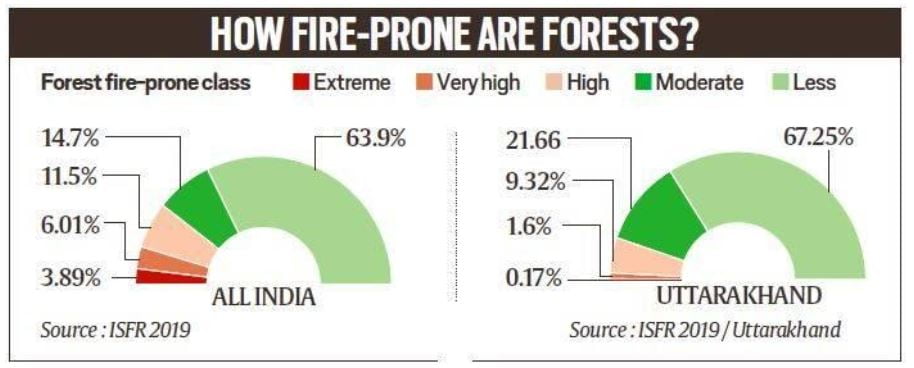UPSC Articles
ENVIRONMENT/ GEOGRAPHY/ GOVERNANCE
Topic:
- GS-1: Geographical phenomena
- GS-3: Environment and Ecology, Bio diversity – Conservation, environmental degradation, environmental impact assessment, Environment versus Development
- GS-3: Issues relating to deforestation, land use pattern and use of fossil fuel.
Forest Fires
Context: April-May is the season when forest fires take place in various parts of the country. Since the start of 2021, there has been a series of forest fires in Himachal Pradesh, Nagaland-Manipur border, Odisha, Madhya Pradesh, and Gujarat, including in wildlife sanctuaries

Image Source: Indian Express
How prone to fire are India’s forests?
- As of 2019, about 21.67% (7,12,249 sq km) of the country’s geographical area is identified as forest, according to the India State of Forest Report 2019 (ISFR) released by the Forest Survey of India. Tree cover makes up another 2.89% (95, 027 sq km).
- Based on previous fire incidents and recorded events, forests of the Northeast and central India regions are the most vulnerable areas to forest fires
- Forests in Assam, Mizoram and Tripura have been identified as ‘extremely prone’ to forest fire.
- States with large forest areas under the ‘very highly prone’ category include Andhra Pradesh, Manipur, Meghalaya, Mizoram, Nagaland, Odisha, Maharashtra, Bihar and Uttar Pradesh.
- Western Maharashtra, Southern Chhattisgarh and areas of Telangana and Andhra Pradesh, along with central Odisha, are turning into ‘extremely prone’ forest fire hotspots, the 2020-2021 annual report of the MoEFCC said.
- Areas under the ‘highly prone’ and ‘moderately prone’ categories make up about 26.2% of the total forest cover — a whopping 1,72,374 sq km.
- Uttarakhand and Himachal Pradesh are the two states that witness the most frequent forest fires annually. In Uttarkhand, 24,303 sq km (over 45 per cent of the geographical area) is under forest cover.
What causes forest fires?
- Forest fires can be caused by a number of natural causes, but officials say many major fires in India are triggered mainly by human activities.
- Emerging studies link climate change to rising instances of fires globally, especially the massive fires of the Amazon forests in Brazil and in Australia in the last two years.
- Fires of longer duration, increasing intensity, higher frequency and highly inflammable nature are all being linked to climate change.
- In India, forest fires are most commonly reported during March and April, when the ground has large quantities of dry wood, logs, dead leaves, stumps, dry grass and weeds that can make forests easily go up in flames if there is a trigger. Under natural circumstances, extreme heat and dryness, friction created by rubbing of branches with each other also have been known to initiate fire.
- In Uttarakhand, the lack of soil moisture too is being seen as a key factor. In two consecutive monsoon seasons (2019 and 2020), rainfall has been deficient by 18% and 20% of the seasonal average, respectively.
- But, forest officials say most fires are man-made, sometimes even deliberately caused. Even a small spark from a cigarette butt, or a carelessly discarded lit matchstick can set the fire going.
- For example, in Odisha, which saw a major fire recently in Simlipal forest, villagers are known to set dry leaves to fire in order to collect mahua flowers, which go into preparation of a local drink
Why are forest fires difficult to control?
- Difficult Terrain: The locality of the forest and access to it pose hurdles in initiating firefighting efforts.
- Manpower Shortage: During peak season, shortage of staff is another challenge in dispatching firefighting teams. Timely mobilisation of forest staff, fuel and equipment, depending on the type of fire, through the thick forests remain challenges.
- Outdated Techniques: As it is impossible to transport heavy vehicles loaded with water into the thick forests, a majority of fire dousing is initiated manually, using blowers and similar devices. But there have been incidents when forest fires were brought under control using helicopter services.
- Weather Factors: Wind speed and direction play a critical role in bringing a forest fire under control. The fire often spreads in the direction of the winds and towards higher elevations
What factors make forest fires a concern?
- Forest’s role in mitigation and adaptation to climate change: They act as a sink, reservoir and source of carbon. A healthy forest stores and sequesters more carbon than any other terrestrial ecosystem.
- Endangers Livelihood of people: In India, with 1.70 lakh villages in close proximity to forests (Census 2011), the livelihood of several crores of people is dependent on fuelwood, bamboo, fodder, and small timber.
- Impacts regeneration capacity of Ecosystem: Forest fires can have multiple adverse effects on the forest cover, soil, tree growth, vegetation, and the overall flora and fauna. Fires render several hectares of forest useless and leave behind ash, making it unfit for any vegetation growth.
- Shrinkage of Forests: Heat generated during the fire destroys animal habitats. Soil quality decreases with the alteration in their compositions. Soil moisture and fertility, too, is affected. Thus forests can shrink in size. The trees that survive fire often remain stunted and growth is severely affected.
What efforts are being taken to protect forests from fire?
- Since 2004, the FSI developed the Forest Fire Alert System to monitor forest fires in real time. In its advanced version launched in January 2019, the system now uses satellite information gathered from NASA and ISRO.
- Real-time fire information from identified fire hotspots is gathered using MODIS sensors (1km by 1km grid) and electronically transmitted to FSI.
- This information is then relayed via email at state, district, circle, division, range, beat levels. Users of this system in the locality are issued SMS alerts. The FSI system in January 2019 had over 66,000 users.
Connecting the dots:














